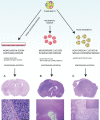In vivo models of primary brain tumors: pitfalls and perspectives
- PMID: 22679124
- PMCID: PMC3408261
- DOI: 10.1093/neuonc/nos135
In vivo models of primary brain tumors: pitfalls and perspectives
Abstract
Animal modeling for primary brain tumors has undergone constant development over the last 60 years, and significant improvements have been made recently with the establishment of highly invasive glioblastoma models. In this review we discuss the advantages and pitfalls of model development, focusing on chemically induced models, various xenogeneic grafts of human cell lines, including stem cell-like cell lines and biopsy spheroids. We then discuss the development of numerous genetically engineered models available to study mechanisms of tumor initiation and progression. At present it is clear that none of the current animal models fully reflects human gliomas. Yet, the various model systems have provided important insight into specific mechanisms of tumor development. In particular, it is anticipated that a combined comprehensive knowledge of the various models currently available will provide important new knowledge on target identification and the validation and development of new therapeutic strategies.
Figures





Similar articles
-
In vivo animal models for studying brain metastasis: value and limitations.Clin Exp Metastasis. 2013 Jun;30(5):695-710. doi: 10.1007/s10585-013-9566-9. Epub 2013 Jan 16. Clin Exp Metastasis. 2013. PMID: 23322381 Review.
-
Rat brain tumor models in experimental neuro-oncology: the 9L, C6, T9, F98, RG2 (D74), RT-2 and CNS-1 gliomas.J Neurooncol. 1998 Jan;36(1):91-102. doi: 10.1023/a:1005805203044. J Neurooncol. 1998. PMID: 9525831 Review.
-
Establishment and Characterization of a Tumor Stem Cell-Based Glioblastoma Invasion Model.PLoS One. 2016 Jul 25;11(7):e0159746. doi: 10.1371/journal.pone.0159746. eCollection 2016. PLoS One. 2016. PMID: 27454178 Free PMC article.
-
Effects of the lysosomal destabilizing drug siramesine on glioblastoma in vitro and in vivo.BMC Cancer. 2017 Mar 7;17(1):178. doi: 10.1186/s12885-017-3162-3. BMC Cancer. 2017. PMID: 28270132 Free PMC article.
-
Glioblastoma spheroids produce infiltrative gliomas in the rat brainstem.Childs Nerv Syst. 2017 Mar;33(3):437-446. doi: 10.1007/s00381-017-3344-y. Epub 2017 Feb 24. Childs Nerv Syst. 2017. PMID: 28236065
Cited by
-
Failure of a patient-derived xenograft for brain tumor model prepared by implantation of tissue fragments.Cancer Cell Int. 2016 Jun 10;16:43. doi: 10.1186/s12935-016-0319-0. eCollection 2016. Cancer Cell Int. 2016. PMID: 27293382 Free PMC article.
-
Phenotypic dynamics of microglial and monocyte-derived cells in glioblastoma-bearing mice.Sci Rep. 2016 May 19;6:26381. doi: 10.1038/srep26381. Sci Rep. 2016. PMID: 27193333 Free PMC article.
-
Oncolytic herpes simplex virus immunovirotherapy in combination with immune checkpoint blockade to treat glioblastoma.Immunotherapy. 2018 Jul;10(9):779-786. doi: 10.2217/imt-2018-0009. Immunotherapy. 2018. PMID: 30008259 Free PMC article.
-
Opportunities and challenges of glioma organoids.Cell Commun Signal. 2021 Oct 11;19(1):102. doi: 10.1186/s12964-021-00777-0. Cell Commun Signal. 2021. PMID: 34635112 Free PMC article. Review.
-
Human organotypic brain slice culture: a novel framework for environmental research in neuro-oncology.Life Sci Alliance. 2019 Jun 27;2(4):e201900305. doi: 10.26508/lsa.201900305. Print 2019 Aug. Life Sci Alliance. 2019. PMID: 31249133 Free PMC article.
References
-
- Kerbel RS. What is the optimal rodent model for anti-tumor drug testing? Cancer Metastasis Rev. 1998;17(3):301–304. - PubMed
-
- Kerbel RS. Human tumor xenografts as predictive preclinical models for anticancer drug activity in humans: better than commonly perceived—but they can be improved. Cancer Biol Ther. 2003;2(4 suppl 1):S134–S139. - PubMed
-
- Peterson JK, Houghton PJ. Integrating pharmacology and in vivo cancer models in preclinical and clinical drug development. Eur J Cancer. 2004;40(6):837–844. - PubMed
-
- Hesselager G, Holland EC. Using mice to decipher the molecular genetics of brain tumors. Neurosurgery. 2003;53(3):685–694. discussion 695. - PubMed
-
- Hanahan D, Weinberg RA. The hallmarks of cancer. Cell. 2000;100(1):57–70. - PubMed
Publication types
MeSH terms
LinkOut - more resources
Full Text Sources
Other Literature Sources
Medical
Molecular Biology Databases

